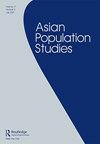Factors delaying marriage in Korea: an analysis of the Korean population census data for 1990–2010
IF 1.5
4区 社会学
Q2 DEMOGRAPHY
引用次数: 14
Abstract
ABSTRACT The Korean total fertility rate is one of the lowest in the world. This study assesses a broad range of factors associated with delayed first marriages, an important determinant of low fertility, using the Korean Population Census 2 per cent sample from 1990, 1995, 2000, 2005 and 2010 and other data sources. Using a multivariate logistic regression, we examine the probability of ever being married for men and women aged 30–34 and 35–39 for different years. We find that women with higher education delay marriage compared to those with a high school degree. Highly educated men marry earlier than men with high school or less education, particularly those aged 35–39. The strongest gender effect occurs among those working in agriculture, a declining industry in Korea. Men working in agriculture are much less likely to marry by age 40, but women marry earlier. In 2005 and 2010, men working in stable, high-paying industries marry earlier, with similar effects for women aged 30–34. Finally, several regional characteristics are associated with delayed marriage including higher housing prices, higher income for women, lower unemployment rate for young women, and higher income inequality, lower income, and higher unemployment rate for men.韩国晚婚因素:1990-2010年韩国人口普查数据分析
韩国是世界上总生育率最低的国家之一。本研究利用1990年、1995年、2000年、2005年和2010年韩国人口普查2%的样本和其他数据来源,评估了与初婚推迟相关的一系列因素,这是低生育率的一个重要决定因素。使用多元逻辑回归,我们检查了30-34岁和35-39岁的男性和女性在不同年份结婚的概率。我们发现,与高中学历的女性相比,受过高等教育的女性会推迟结婚。受过高等教育的男性比受过高中教育或教育程度更低的男性结婚更早,尤其是35-39岁的男性。性别影响最大的是农业,这是韩国正在衰退的产业。从事农业工作的男性在40岁之前结婚的可能性要小得多,但女性结婚得更早。2005年和2010年,在稳定、高收入行业工作的男性结婚更早,对30-34岁的女性也有类似的影响。最后,几个区域特征与晚婚有关,包括较高的房价、较高的女性收入、较低的年轻女性失业率,以及较高的收入不平等、较低的收入和较高的男性失业率。
本文章由计算机程序翻译,如有差异,请以英文原文为准。
求助全文
约1分钟内获得全文
求助全文
来源期刊

Asian Population Studies
DEMOGRAPHY-
CiteScore
3.30
自引率
14.30%
发文量
12
期刊介绍:
The first international population journal to focus exclusively on population issues in Asia, Asian Population Studies publishes original research on matters related to population in this large, complex and rapidly changing region, and welcomes substantive empirical analyses, theoretical works, applied research, and contributions to methodology.
 求助内容:
求助内容: 应助结果提醒方式:
应助结果提醒方式:


